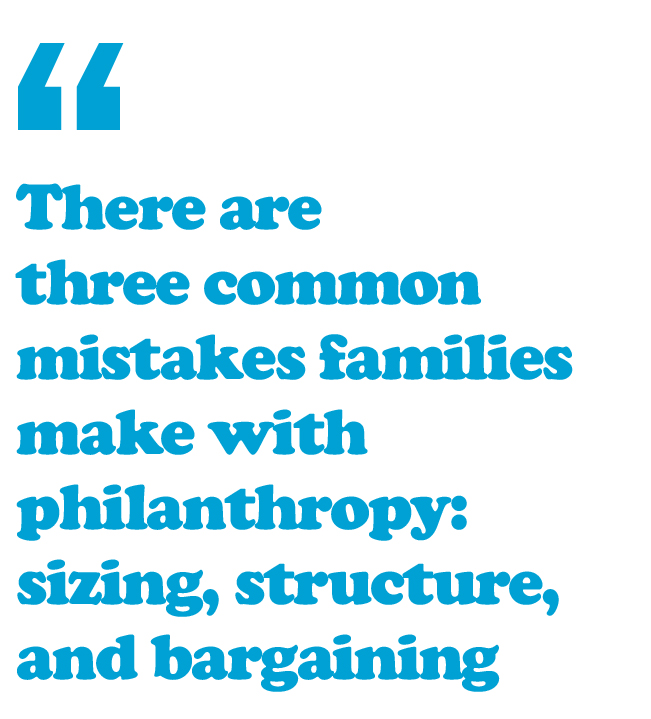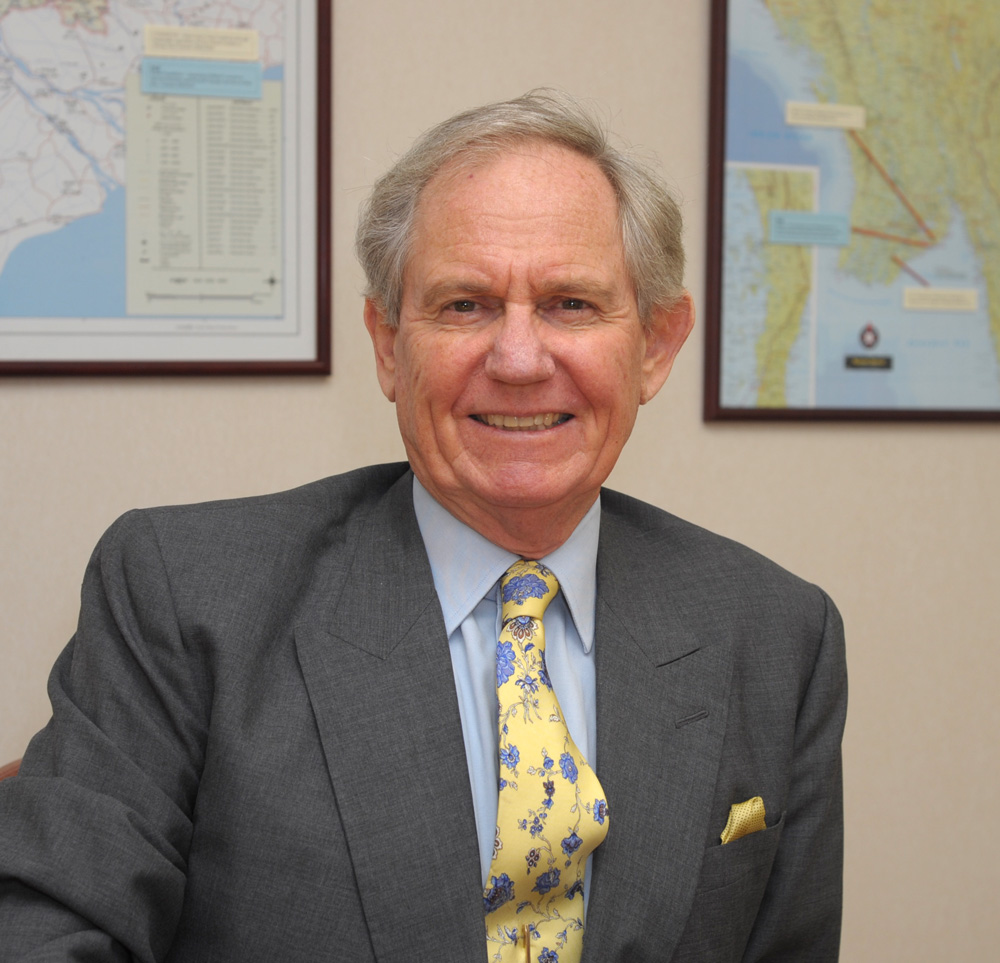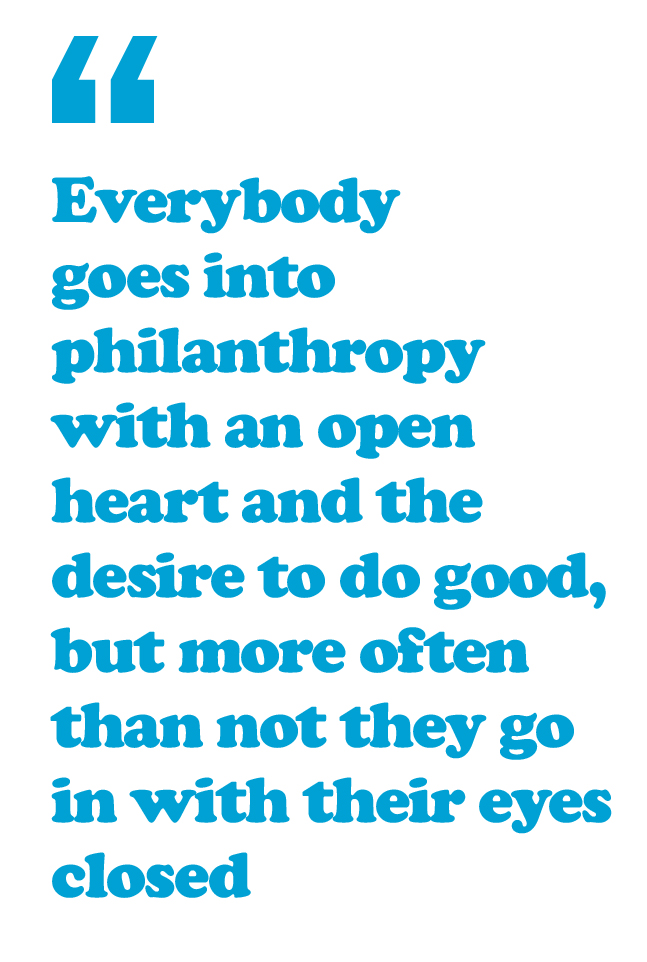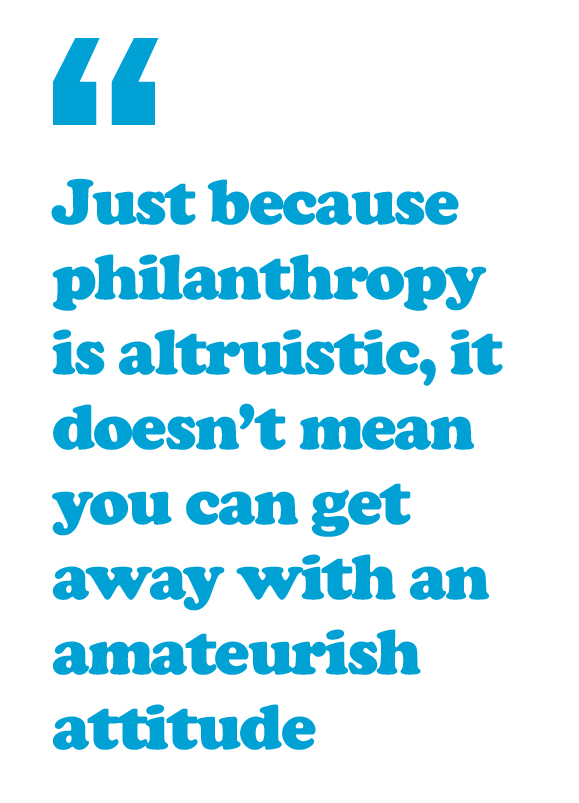Fortune and glory: How to avoid the pitfalls of philanthropy

One of the common mistakes families make with philanthropy is to allow emotion and wishful thinking to override logic and thoughtful analysis. Michael Finnigan takes a look at some of the pitfalls that regularly catch families off-guard.
Those who have seen Indiana Jones and the Raiders of the Lost Ark will remember the opening temple scene in which the eponymous archaeologist narrowly dodges a falling door only to find himself in the path of a giant rolling boulder. In many ways it is a scene that captures the essence of family ownership: just when you think you have cleared the final hurdle, another is set before you. While there are dangers across all aspects of private ownership, one that regularly takes families by surprise is philanthropy. So what is the best way to avoid these figurative traps? And how can families ensure their giving is impactful?
 Perhaps it is best to start with an overview. Traditionally, philanthropy is the function of a family foundation, yet donations will occasionally come directly from a family member. Thanks to an industry-wide feeling that philanthropy helps to engage the next generation it is increasingly being tackled by the family office – a common training ground for future responsibilities of leadership.
Perhaps it is best to start with an overview. Traditionally, philanthropy is the function of a family foundation, yet donations will occasionally come directly from a family member. Thanks to an industry-wide feeling that philanthropy helps to engage the next generation it is increasingly being tackled by the family office – a common training ground for future responsibilities of leadership.
Consequently, the majority of family offices have their own philanthropic programmes, with a further 8% looking to take on their own programmes in the next 18 months, according to the Global Family Office Report 2015. On average, offices that are engaged in philanthropy have endowments of about 2.5% of assets under management, equating to $20 million on average.
But when you consider the report's findings that two of the main purposes of office philanthropy are for the engagement of the next generation and for family legacy, is it any wonder that only 45% give with clear focus? This can lead to a slew of mistakes, including: failing to establish a mission statement, going into projects without quantifiable goals, and not conducting proper due diligence on funding partners. That is just the tip of the iceberg.

“There are three common mistakes families make with philanthropy: sizing, structure, and bargaining,” explains Andy Hart, co-managing partner at Delegate Advisors, a San Francisco-based family office adviser.
“Yet if you have a good plan that covers these areas, most future philanthropy problems resolve themselves. When they do not take the time to establish a philanthropic strategy, families often regret the early years.”
According to Hart, one of the first steps for effective family philanthropy is to address whether the family has sized their pledge correctly. He notes this is especially true for cases where the pledge is not a fixed amount, pointing to one case in which a pre-eminent family client on the West Coast was forced to sell their business to honour a charitable venture that went well over budget and suffered from large operational losses.
“Structure is another area families must consider,” Hart says.
“Sometimes families make pledges without considering how the structure of the pledges might be more impactful had they considered a different approach. For example, consider a family that has pledged $100 million for naming rights for a new law school building at a major university. Rather than making the donation at one time, they could spread the donation out over a number of years – say, $5 million per year – to be sure they are capturing the full charitable tax benefits available to them under the US tax code.”
Having addressed the structure and size of a pledge, Hart says families might also consider using their personal network to secure better deals. Using the aforementioned example of naming a new building, Hart points out that a family might be able to secure naming rights for a lesser amount by acting as the lead pledge and helping to secure smaller pledges.

Yet putting those structures in place is no easy task. A recent joint report from advisory firms Moore Stephens and Phoenix Hayward, Philanthropy for Family Offices report, even advises offices to regularly review these processes in order to achieve maximum impact. As part of the report, family office respondents ranked philanthropy processes by order of importance: a clear understanding of their philanthropy strategy (97%); due diligence on potential recipients (94%); and measuring the impact of their philanthropy (84%) gives an idea of priorities.
Undoubtedly some processes are more important than others. For former soldier and diplomat Christopher Lavender (right), who set up the charitable foundation of the Kadoorie family in Hong Kong in 1997, the most important process is to treat philanthropy like any other investment.
“Everybody goes into philanthropy with an open heart and the desire to do good, but more often than not they go in with their eyes closed,” Lavender says.
“One of the most important lessons for family offices is to ensure that they operate with a business approach, having identified the sectors and geographical areas that they want to target. They also want to think about how long they are going to fund particular projects, and whether they want to get anything out of it in terms of publicity. In other words, you have got to get your terms and objectives well sorted out before you take it forward.”

Lavender identifies the mission statement and charitable objectives as two of most important steps towards an impactful philanthropic programme. With those two functions in place, offices are able to avoid awkward conversations with demanding charities if their request does not line up with the office's stated purpose and vision.
In much the same way as investments, having those quantifiable goals in place helps philanthropy staff show family members that their projects are having impact, thereby giving the team a mandate for taking on further projects. Nevertheless, finding suitable funding partners, those organisations that share experience and purpose, is one of the biggest challenges.
While Lavender says there is no right way to choose projects, with some finding success online and via word of mouth, he often advises a proactive approach as the best way to attract like-minded partners and projects.
“Lots of family offices take on projects and funding partners through word of mouth, although some find success through the internet,” Lavender explains.
“Prolific family foundations and offices are often approached because they've been recommended by a former partner. When they're not seeking out new partners, they're out talking to fellow philanthropists to see how they do things in different areas. You never want to close yourself off to what other people might have to say. I think that's an important part of identifying partners and the projects.”
 While Lavender stresses that good communication helps to build confidence, trust, and impact, he believes that frank discussion of each other's flaws ultimately builds the best partnerships. Through these discussions, the former soldier says it is possible to identify weaknesses before they arise and help assess whether the funding partners can plug the gaps in their programmes.
While Lavender stresses that good communication helps to build confidence, trust, and impact, he believes that frank discussion of each other's flaws ultimately builds the best partnerships. Through these discussions, the former soldier says it is possible to identify weaknesses before they arise and help assess whether the funding partners can plug the gaps in their programmes.
“Even if a family foundation or office decides it cannot help a funding partner with potential weaknesses, the ultimate goal is honesty and good communication,” he explains.
“That means they may put the funding partner in contact with somebody else who has had the same problems, who may be able to offer them advice, and it also leaves the door open for future collaboration. I think confidence, trust, and communication are key to any good relationship.”
Communication then is the hallmark of any good philanthropic partnership. In agreement is Plum Lomax, deputy head of the Funders team at London-based consultant New Philanthropy Capital, which has worked with family offices for more than 14 years. She says that it is important to put in place systems to ensure that a prospective partner is responsible with family money.
“There are two core questions that we tend to ask when considering a potential partner or charity,” Lomax explains.

“Will the cash achieve what the philanthropist wants? Can the charity or partner demonstrate what it does and the effectiveness of its activities? If you don't ask these questions then the money, even if it achieves some social good, probably won't stretch as far as it could.”
Another area in which poor communication can become a problem is between the family office employees and the family members, Lomax says. The former head of European equity strategy at Merrill Lynch points out that she regularly sees family office employees who are reluctant to talk about problems that fall outside of their main expertise, and often issues can fall by the wayside.
“Around 90% of the time it falls to the family member to initiate that conversation,” she explains.
“Family office employees do not need to become experts on all philanthropic subjects, but they need to know the options available to their clients and who to turn to for the most relevant advice. Communication is important to ensure that family philanthropy is impactful.”
One of the best ways to ensure that money is correctly allocated and is achieving its potential is to regularly arrange site visits. Typically, site visits include time for introductions, a tour (if appropriate), a brief presentation, questions and answers, and a discussion of the proposal review process. Lavender, director of the Kadoorie Charitable Foundation, is a fierce advocate of site visits and points to one occasion in which a site visit made a startling discovery.
 “In one project, a community-based organisation that was implementing the project on the ground, that had received money from one of our international NGO [non-governmental organisation] partners, had in fact been embezzling money for around four months,” Lavender explains. “While they only managed to embezzle around $6,000, the international NGO had failed to pass on the information. We carried out damage limitation but unfortunately for the ultimate beneficiaries we ended up withdrawing the funding. But obviously that was something we would not have found out if we had not visited the project on the ground.”
“In one project, a community-based organisation that was implementing the project on the ground, that had received money from one of our international NGO [non-governmental organisation] partners, had in fact been embezzling money for around four months,” Lavender explains. “While they only managed to embezzle around $6,000, the international NGO had failed to pass on the information. We carried out damage limitation but unfortunately for the ultimate beneficiaries we ended up withdrawing the funding. But obviously that was something we would not have found out if we had not visited the project on the ground.”
According to Lavender, one of the best ways for family offices to see the impact of their philanthropy is through regular reporting. The foundation director often advises philanthropists to develop their own systems, despite being aware of some organisations that use over-the-counter software, such as Mango and Conical Hat.
He says proprietary reporting helps to ensure that all key metrics are made available, such as finances received, overspends, underspends, and any updates on the state of the budget. Another important field is for the discussion of any problems encountered, such as meeting deadlines or whether goals were unachievable in the first place.
“Reporting depends on the size of your organisation and what you can handle,” Lavender explains.

“Most funding organisations will only need to ask for reports at six-monthly intervals, anything more than this becomes time consuming for the funding partner and is frankly unnecessary. No matter the frequency of reporting, it is important to only disperse the next stage of funding once the report has been received. That's one control measure that ensures proper reporting. Another is to hold back 10% of the sum at the end of the project to ensure that the final report is always delivered.”
On a larger scale, one of the most pressing problems facing philanthropists in 2016 stems from government bureaucracy, according to Lavender. Tax laws introduced in the US to prevent money laundering have made it more time consuming to move money around, particularly into Europe, which in turn makes it more difficult to fund philanthropic projects.
In India and Bangladesh, they have introduced the Foreign Currency Regulation Act, wherein philanthropists need government permission before they can allocate funds. There are also issues with getting money out of those countries: an increasing number of philanthropists have reportedly adopted a system of “relay funding” with partners in order to circumnavigate these issues.
With these points in mind, it is safe to assume that philanthropy is not the walk in the park some might have you believe: if you go in the hope that good intentions alone will carry you through, one might find that results are likely to backfire.
As Lavender concludes: “Just because philanthropy is altruistic, it doesn't mean you can get away with an amateurish attitude. There are predators out there, and there are people with egos, agendas, and jealousies, and you've got to approach philanthropy as you do any business.”






